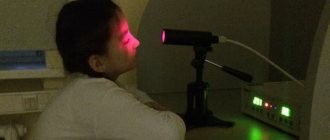The powerful lymph nodes located around the pharynx cannot cope with the attack of the pathogen, so the body begins to produce antibodies that can find pathogenic bacteria, paralyzing their activity.
As a result, streptococci are defeated, but the child’s body produces so many antibodies that, in addition to foreign cells, the body’s own tissues, primarily the heart and joints, begin to suffer. Therefore, it is always better to entrust the treatment of sore throat in a child to a qualified doctor.
In 10% of cases, sore throat in children can be caused by Staphylococcus aureus, rarely pneumococcus, Haemophilus influenzae, chlamydia and fungal flora. Viral pathogens (adenoviruses, herpes virus) more often attack the body of children under 3 years of age.
The main causes of sore throat in children
What exactly caused a child’s sore throat may depend on age, time of year and climate zone. Most often, a sore throat is caused by viruses, while bacteria are the second most likely cause of the disease. All pathogens are transmitted mainly by contact, when a child touches his nose, eyes or mouth with hands that have been in contact with an infected person or contaminated objects (toys, door handles, cutlery). To determine the causes of sore throat, laboratory tests are recommended.
There are many viruses known to cause pain and swelling in the throat. The most common respiratory viruses cause ARVI. Other viral pathogens that can cause symptoms of a sore throat include herpes influenza viruses, enteroviruses, adenoviruses, and the Epstein-Barr virus (the cause of mononucleosis).
The most common bacterial causative agent of sore throats is group A streptococci. In winter or early spring, up to a third of sore throats in school-age children are caused by streptococci. Streptococcal sore throat is uncommon in children under 2-3 years of age.
Bacterial tonsillitis is characterized by a sudden onset of the disease, with sore throat, nausea and vomiting, and fever above 38.3°C. In young children, streptococcal infection can occur with a temperature of less than 38.3°C. Infants under one year of age with sore throat may have a low-grade fever.
Most cases of sore throat are viral and do not require treatment. But children with group A strep throat need to be treated with antibiotics to prevent the infection from spreading and potentially dangerous complications such as rheumatic heart valve disease.
Antibiotics in the treatment of tonsillar pathology
A.I. KRYUKOV, Doctor of Medical Sciences, Professor, N.L. KUNELSKAYA
, Doctor of Medical Sciences, Professor,
G.Yu.
TSARAPKIN , Doctor of Medical Sciences,
A.S.
TOVMASYAN , Ph.D.,
O.A.
KISELEV ,
Research Clinical Institute of Otorhinolaryngology named after.
L.I. Sverzhevsky Department of Health, Moscow Tonsillar pathology is one of the most common pathologies throughout the world. People of all ages are susceptible to it, but inflammatory diseases of the tonsils are most relevant in childhood due to the risk of severe complications. Algorithms for the treatment of tonsillar pathology are described in various international and national guidelines, however, the practical choice of antimicrobial agents often causes difficulties for practitioners.
Up to 80% of acute and exacerbations of chronic respiratory diseases are accompanied by the symptom of sore throat, which is one of the most common reasons for patients to visit a pediatrician, therapist, otolaryngologist and doctors of other specialties. Acute inflammation of the pharynx is the cause of 1.1% of the total number of patient visits to doctors; 6% of all visits to the pediatrician; acute tonsillopharyngitis is among the 20 most frequently diagnosed diseases [1, 2]. In this case, sore throat can be a dominant problem, inevitably affecting the patient’s quality of life [3]. The relevance of the tonsillar problem is determined not only by the high prevalence of the disease, but also by the significant risk of developing associated systemic diseases, such as acute rheumatic fever, bacterial endocarditis, glomerulonephritis, toxic shock, etc.
In domestic practice, in case of acute infection involving the tonsils, the term “tonsillitis” or “tonsillitis” is usually used, and inflammation of the lymphoid follicles of the posterior pharyngeal wall is usually characterized by the term “pharyngitis”. In clinical practice, a combination of tonsillitis and pharyngitis is often observed, especially in childhood, therefore in the literature, especially in English, the term “tonsillopharyngitis” is widely used, suggesting inflammation of the walls of the oropharynx. In particular, the development of bacterial tonsillitis is often caused by an infection caused by beta-hemolytic streptococcus group A (GABHS), pharyngitis is usually caused by respiratory viruses, adenoiditis by viruses, Streptococcus pneumoniae, Haemophilus influenzae, Staphylococcus aureus, Moraxella catarrhalis
, epiglottitis -
H. influenzae
.
Acute tonsillitis is classified into primary (banal) tonsillitis (catarrhal, follicular, lacunar, mixed, phlegmonous), secondary, arising from infectious diseases (scarlet fever, measles, diphtheria, syphilis, etc.), from blood diseases (leukemia, agranulocytosis, monocytosis), atypical (Simanovsky - Plaut - Vincent, viral, fungal). In clinical practice, the most common epidemic form of the disease is when the infection is transmitted by airborne droplets or contact and causes primary sore throats. In childhood, up to 30% of sore throats are bacterial in nature; in the vast majority of cases, the etiological factor is GABHS. Much more often, the development of acute tonsillitis is caused by a viral infection, primarily adenoviruses, respiratory syncytial viruses, and the Epstein-Barr virus. Viral forms of acute tonsillitis predominantly occur in the autumn-winter period and predominate in children of the first 3 years of life (up to 90%), and over the age of 5 years the frequency of bacterial forms increases (up to 50%) [4]. Intracellular pathogens also play a significant role in the development of the disease in childhood - Mycoplasma pneumoniae, Chlamydia pneumoniae, which are inoculated in 10-24 and 5-21% of cases, respectively, and the entire pharyngeal epithelium is infected with chlamydia, which may cause the process to become chronic [5, 6 ].
It is believed that the development of sore throat occurs as a hyperergic allergic reaction, and the sensitization of the body is caused by a variety of microflora of tonsil lacunae and protein breakdown products, and the trigger for the development of the disease can be various factors of an exogenous or endogenous nature. An allergic factor can serve as a prerequisite for the occurrence of infectious and allergic diseases, such as rheumatism, glomerulonephritis, nonspecific infectious polyarthritis, which are quite often a complication of tonsillitis, especially induced by GABHS, since they have a high adhesive ability to the membranes of the mucous membranes, resistance to phagocytosis, emit numerous exotoxins that cause a strong immune response contain antigens that cross-react with the myocardium, and the immune complexes that include them are involved in kidney damage [7, 8].
Treatment of acute tonsillitis and pharyngitis is complex and includes irrigation therapy, the use of local antibacterial drugs and systemic antibiotics.
With the viral etiology of tonsillitis and pharyngitis, it is possible to limit oneself to the prescription of irrigation therapy and local antiseptics, however, the bacterial etiology of the disease, especially GABHS, requires the mandatory use of systemic antibiotics.
In this regard, it is extremely important to follow the principles of rational antibacterial therapy, namely: prescribing the drug with the aim of maximizing clinical and bacteriological recovery; the spectrum of action of the drug must correspond to the probable causative agent of the infection, overcome possible resistance mechanisms and create a maximum concentration at the site of infection. What is especially important in pediatric practice is that the prescribed drug should be easy to use.
Adequate interpretation of the leading etiological factor (bacteria, viruses, fungi, protozoa), the clinical form of tonsillitis (primary or secondary), the severity of the disease (in acute tonsillitis there is usually one pathogen, in exacerbation of chronic tonsillitis - a mixed flora) [9] make it possible to prescribe therapy empirically, with taking into account information about sensitivity to antibiotics, the ability of the drug to create adequate concentrations at the site of infection and the proven effectiveness and safety of its use.
Traditionally, the drugs of choice for GABHS tonsillitis are semi-synthetic broad-spectrum penicillins. They are effective against the most likely pathogens of tonsillitis (GABHS), belong to a safe group of antibiotics, and all have oral forms. With a typical picture of the disease, they are considered as the drugs of choice.
The most famous representative of this group is amoxicillin, which has a pronounced bactericidal effect. The mechanism of action of the drug is associated with inhibition of the synthesis of peptidoglycan (a substance that is the basis of the bacterial membrane), which leads to disruption of the integrity of bacterial cell membranes and their death. Amoxicillin is active against strains of Staphylococcus spp. and Streptococcus spp.
., as well as
Neisseria meningitidis, Neisseria gonorrhoeae, Escherichia coli, Salmonella spp., Shigella spp., Klebsiella spp.
Therapeutic concentrations of amoxicillin are maintained in plasma for 8 hours after oral administration. Amoxicillin is rapidly absorbed from the digestive tract and reaches peak plasma concentrations within 1-2 hours after administration. Food intake has virtually no effect on the bioavailability and rate of absorption of amoxicillin. The active component is stable in the acidic environment of the stomach. High concentrations of the active substance are created in bronchial secretions, sputum, blood plasma, peritoneal and pleural fluid, as well as in lung tissue. Concentrations of amoxicillin in tissues and biological fluids are proportional to the dose taken.
During the metabolism of amoxicillin, pharmacologically inactive substances are formed. About 50-70% of the dose taken is excreted unchanged by the kidneys, about 10-20% by the liver, the rest of amoxicillin is excreted in the form of metabolites. Amoxicillin produced in Russia, Amosin (JSC Sintez, Kurgan), is currently available. The drug is intended for oral use. Capsules are taken before or after meals at regular intervals. As a rule, adults and children over 10 years of age (with a body weight of more than 40 kg) are prescribed 500 mg of amoxicillin three times a day. In severe cases of the disease, the dose of amoxicillin is increased to 750-1,000 mg three times a day. For children from 5 to 10 years of age, the therapeutic dose is 250 mg of amoxicillin three times a day. The average course of therapy lasts from 5 to 12 days (as a rule, therapy is continued for 2-3 days after the disappearance of clinical manifestations of the disease).
However, it should be taken into account that H. influenzae
, as well as
M. catarrhalis
are active producers of β-lactamases. This dictates the need to use protected aminopenicillins as initial therapy drugs, which are rightfully considered the “gold standard” for the treatment of acute purulent-inflammatory pathology of the ENT organs. One of the most commonly used antibiotics in the treatment of tonsillar pathology is a combination drug containing semisynthetic penicillin - amoxicillin and an irreversible lactamase inhibitor - clavulanic acid. Amoxicillin clavulanate is represented on the market by a number of trade names, among which the Russian drug Arlet® can be distinguished. Clavulanic acid, due to the presence of a β-lactam ring in its structure, forms stable complexes with bacterial lactamases and protects amoxicillin from destruction by these enzymes. This combination of components ensures high bactericidal activity of the drug. Arlet® is active against both amoxicillin-sensitive microorganisms and strains producing β-lactamases:
• gram-positive aerobes: Streptococcus pneumoniae
, GABHS,
Staphylococcus aureus
(except methicillin-resistant strains),
S. epidermidis
(except methicillin-resistant strains),
Listeria spp., Enteroccocus spp.;
• gram-negative aerobes:
Bordetella pertussis, Brucella spp., Campylobacter jejuni, Escherichia coli, Gardnerella vaginalis, Haemophilus influenzae, H. ducreyi, Klebsiella spp., Moraxella catarrhalis, Neisseria gonorrhoeae, N. meningitidis, Pasteurela multocida, Proteus spp., Salmonella spp. ., Shigella spp., Vibrio cholerae, Yersinia enterocolitica
;
• anaerobes: Peptococcus spp., Peptostreptococcus spp., Clostridium spp., Bacteroides spp., Actinomyces israelii
.
The pharmacokinetics of amoxicillin and clavulanic acid have many similarities. Both components are well absorbed from the gastrointestinal tract; food intake does not affect the degree of their absorption. Peak plasma concentrations are reached approximately one hour after taking the drug. Amoxicillin and clavulanic acid are characterized by good distribution in body fluids and tissues, creating therapeutic concentrations in areas of upper respiratory tract infections (tonsils, pharyngeal mucosa, paranasal sinuses, tympanic cavity, etc.). Amoxicillin is excreted unchanged from the body by the kidneys through tubular secretion and glomerular filtration. Clavulanic acid is eliminated through glomerular filtration, partially in the form of metabolites. Small amounts may be excreted through the intestines and lungs. The half-life is 1–1.5 hours. In patients with severe renal failure, the half-life of amoxicillin increases to 7.5 hours, clavulanic acid - to 4.5.
Amoxicillin/clavulanate is well tolerated. Adverse events are relatively rare and include diarrhea, nausea and skin rash. Arlet® tablets should be taken orally, without chewing, during meals, with a small amount of water. For adults and children over 12 years of age (or with a body weight of more than 40 kg), the usual dose for mild to moderate infections is 1 tablet of 250/125 mg 3 times a day. For severe infections, a tablet of 500/125 mg is prescribed 3 times a day; if necessary, tablets of the drug Arlet® are prescribed at a dose of 875/125 mg or 1 tablet of 500/125 mg 3 times a day. The course of treatment lasts up to 5-14 days. The duration of treatment is determined by the attending physician. Treatment should not continue for more than 14 days without repeated medical examination.
For atypical manifestations of the disease (mycoplasma and chlamydophilic infections), macrolides are the drugs of choice. They are recommended for use in children as initial therapy in the treatment of atypical forms of tonsillitis, as well as in cases where there is intolerance to beta-lactam antibiotics. Macrolides are considered as alternative antibacterial agents that can be prescribed in the event of a lack of effect from initial therapy, with the development of side and undesirable events associated with the use of first-line drugs [10, 11].
Literature
1. Nash DR, Harman J, Wald ER, Kelleher KJ. Antibiotic prescribing by primary care physicians for children with upper respiratory tract infections. Arch Pediatr Adolesc Med 2002. 156. 11: 1114-1119. 2. Panasiuk L, Lukas W, Paprzycki P. Empirical first-line antibioticotherapy in adult rural patients with acute respiratory tract infections. Ann Agric Environ Med 2007. 14. 2: 305-311. 3. Babiyak V.I., Govorukhin M.I., Mitrofanov V.V. Some psychological aspects of the problem of human “quality of life”. Russian Otorhinol., 2004. 1(8): 3-6. 4. Tatochenko V.K., Bakradze M.D., Darmanyan A.S. Acute tonsillitis in childhood: diagnosis and treatment. Farmateka, 2009. 14: 65-69. 5. Garashchenko T.I., Strachunsky L.S. Antibacterial therapy of ENT diseases in childhood. In the book: Pediatric otorhinolaryngology: A guide for doctors. Ed. M.R. Bogomilsky, V.R. Chistyakova. T. II. M.: Medicine, 2005: 275-317. 6. Linkov V.I., Tsurikova G.P., Nuralova I.V., Pankina N.A. The significance of chlamydial infection in the development of chronic inflammatory diseases of the pharynx. News of otolaryngology and speech pathology, 1995. 3(4): 146-146. 7. Kryukov A.I. Clinic, diagnosis and treatment of tonsillar pathology (Manual for doctors). M., 2011. 32 p. 8. Luchikhin L.A. Angina. Otorhinolaryngology: national guidelines. Ed. V.T. Palchuna. M.: GEOTAR-Media, 2008: 652–673. 9. Garashchenko T.I. Macrolides in the treatment of acute tonsillitis and its complications in children. RMJ, 2001. 9., 19: 812-816.
Source
: Medical Council, No. 11, 2015
What symptoms indicate a child has a sore throat?
To assume that a child has a dangerous form of streptococcal tonsillitis, one or more of the following symptoms must be present:
- Temperature ≥ 38.3°C
- Season: late autumn, winter or early spring.
- The child does not have a cough
- The child's age is from 5 to 15 years.
- Recent exposure to someone with a sore throat
- Difficulty breathing or swallowing
- The child's voice sounds muffled
- Stiffness in the neck or difficulty opening the mouth
Description of the disease
Lacunar tonsillitis is the third most severe form of tonsillitis.
Pathology can occur in children aged 1 to 18 years. One episode of the disease lasts on average 10-14 days, if the initial treatment is chosen correctly. The disease develops acutely. The chronic form of lacunar tonsillitis is extremely rare (up to 2%). Due to the massive penetration of bacteria into the palatine tonsils, in the absence of adequate treatment, the risk of complications increases:
- formation of peritonsillar abscesses;
- layering of secondary infection with transition to a septic state (sepsis);
- exacerbation of existing chronic diseases.
One common complication of frequent episodes of sore throat in childhood is acute rheumatic fever (formerly “rheumatism”). It develops due to the ability of bacteria (streptococci) to remain in the tissues of the tonsils for a long time. Pathogens trigger autoimmune processes in the body, which leads to the appearance of characteristic symptoms. The most unfavorable are lesions of the cardiovascular system with the formation of acquired heart defects. Therefore, it is so important to carry out adequate and timely treatment of lacunar tonsillitis when symptoms are identified.
What studies confirm that a child has a sore throat?
If there is a suspicion that the child may have streptococcal or the child may have streptococcal tonsillitis or scarlet fever, tests may be carried out to confirm the diagnosis: a rapid test (Strep test) and culture. For both types of tests, the doctor takes a swab from the back and sides of the child's throat. The results of the rapid test are obtained within a few minutes, and the culture will be ready within two days. If the research confirms the streptococcal nature of the disease, the child is prescribed antibiotic therapy. If the result of the Strep test is negative, then an additional culture is done to avoid false negative results.
Features of use
There are several principles for the use of drugs from the group of antibiotics that require mandatory compliance. Violations of them can lead to serious consequences. The drug should always be prescribed by an otolaryngologist, and if not, then by a therapist.
1. At the initial visit, if it is not possible to wait for the results of the smear, a broad-spectrum drug is prescribed for treatment, effective against the main pathogens of the identified pathology. After the results of the study are received, the treatment regimen will be edited if necessary.
2. If there is no result, the drug must be replaced. In such a situation, a second smear may be necessary, since failure of treatment most likely means that a mistake was made in choosing the medicine. If the patient does not comply with the dosage regimen, then the lack of effect from the antibiotic is associated with the development of a drug-resistant form of the pathogen.
3. Minimum course duration is 7 days. Be sure to complete the treatment completely. Even if it seems that the medicine is no longer needed, you should definitely continue taking it. Otherwise, if the patient does not complete the course, it will cause the appearance of a particularly persistent pathogen, against which antibiotics from this category will be useless in the future.
4. When choosing a drug, it is necessary to study the patient’s chart in order to determine which antibiotic drugs have already been administered recently. In this case, you need to choose a different remedy, since the previous one may no longer be effective enough. It is highly undesirable to use the same drug several times in one year. This is allowed only if there is no other way out;
Also, the patient must inform the attending physician about what medications he is taking, since not all drugs can be combined with antibiotics. In this case, therapy is based on a special plan if it is not possible to stop the medication.





